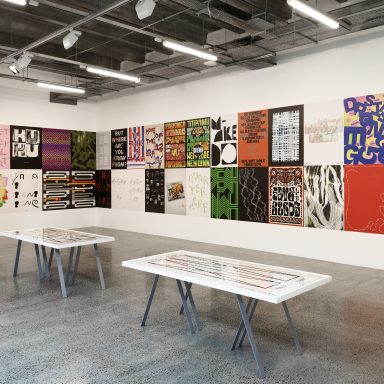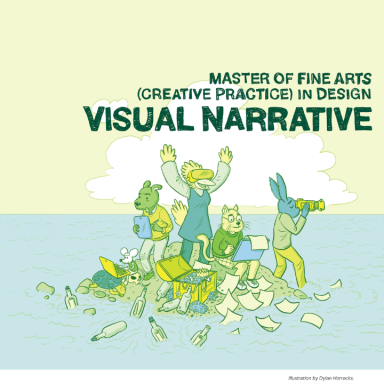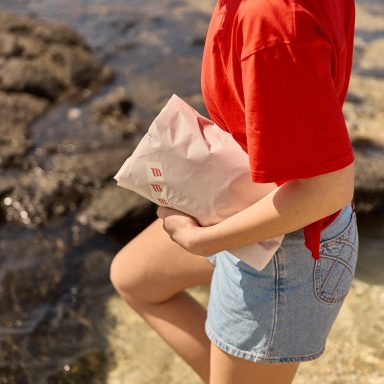Permission to be Creative: 7 things I learned from 7 years of the 100 Days Project
Written by Emma Rogan
Supported by Creative New Zealand

Emma Rogan is a contributor to Aotearoa Design Thinking 2018, a series of commissioned critical design essays published by Design Assembly and funded by Creative New Zealand.

First 100 Days Show
In 2011 I was stuck in a rut with work and felt restless. I looked around for an opportunity for professional development, but at the time there were very few workshops or short courses available in NZ and none at all for experienced designers. The only thing that tempted me was a 16 week film-making course, but I couldn’t afford to take the time off work. So when I happened across the Design Observer blog and read about Michael Beirut’s class at Yale ‘100 Days of Design’ – I was heartened both by his encouraging tone, and the deliberately confined format of the challenge. It sounded difficult enough to be worthwhile, yet simple enough to keep my day job. I immediately decided to give it a go and I invited 30 people who I thought might want to do it too. Over one weekend I set a start-date and sent out printed invitations. Word caught on, and since then over 5,000 people from around the world have taken part in the project.
The idea is very simple; repeat a single creative task (of your own choosing) every day for 100 days. You mustn’t miss a day, and you have to record your daily efforts. With an optional opportunity of exhibiting your completed 100 Day project at the Day 100 Show.
It sounds easy, but it isn’t. Every day requires something new. As well as being time-consuming the project demands space in the mind, and commitment beyond the execution of the task. Ask any hundred dayer and they’ll tell you how challenging it is to turn up every single day, for over three months to execute the same daily task. With all of your self-doubt and perfectionism potentially in attendance.
Seven years on the project has become part of my life. While I took a break this year to start a new business, a group of hundred dayers have organized their own projects, and for the first time ever there is a Northern Hemisphere contingent. The break has allowed me to reflect on some of the things I’ve learned from the project:
The daily work of graphic design is not enough to satiate the desire for self-expression.
I know I can’t speak for all designers, many of whom find their daily work satisfying. For several years when I started out there was just so much to learn on the job that it was deeply fascinating to me as a vocation. But in 2011 I had been working full-time in the industry for just over ten years, and I started to yearn for something that my daily work could not give me. I wanted extension of experience, or change, or newness. When I met up with a long-lost cousin around that time, he asked me if I felt I had compromised my childhood ambitions to be an artist in rejecting that life for graphic design – and I had to admit to him the truth, that yes there had been a compromise.
I don’t regret the decision, I don’t think that as a young person I had the confidence or emotional stability to survive an artist’s existence. But I still harbour a desire for creative expression and as rewarding as my day job is, that desire is distinctly separate from answering client briefs and solving commercial problems through graphic design.
It is easier to start, than to maintain.
The first year 50 people took part, the second I capped it at 100, the third year however was big, I had been invited to give a talk about the project at TEDx in 2012, and it seemed to have captured the imagination of many – about 800 people signed up in 2013 (more would have, but I panicked at the scale of it and shut off registrations). Since then the numbers have ranged from 1,100 – 2,000 sign-ups annually.
It’s been said before, so I am not the first to observe this but when something is small it’s easy to run it without incurring many costs. When I had to find an exhibition space to showcase just 30-40 hundred days projects, there were loads of potential spaces in the city that were willing to accommodate us for either free or for a low fee. But trying to find an exhibition space for one or two hundred projects is a much more difficult challenge.
And it wasn’t just exhibition costs that proved challenging – the first website made things really simple and cheap ($65US per annum on Cargo) and worked for the first two years. Most of those hundred dayers were from my immediate network of friends and colleagues – highly computer-literate design professionals for whom setting up their own blog or website to house their project was easy. However as the project grew, participation changed and it became attractive to an incredibly diverse array of people which in turn changed the nature of the actual projects and brought with it a requirement to better support these different participants.


100 Days websites (above 2011 website, below 2013-2015 website)
Some people struggled to record their own projects online, via a blog or Tumblr (Instagram wasn’t yet a big thing), and yet they wanted their project to be accessible to others. The desire to share throughout the life of the project is a way to be held accountable, and it’s also just much more fun to share and follow the progress of others. Community spirit is a big part of what makes the project appealing. I needed a platform for people to sign up and log in to their own project space, where they could upload each day’s effort. Everyone all in the same place, working away at their projects and supporting each other.
Piri and Craig and the team at Supply helped me build a website. We built an automated registration form and system, allowing each user their own login. The website became an online gallery of thousands of hundred day projects and you can now filter projects by keyword and location. It has developed into an amazing resource and is the home of some incredible work.
Henry Penny continues to help me to this day and has since rebuilt the platform single-handedly and on my tiny budget, so that it is capable of processing large amounts of incoming data. I still pay for hosting of several years of project data. It continues to be expensive and time-consuming to host and run….but I love it, so here we are.
That said, sometimes starting is the biggest hurdle to overcome.
Most seasoned hundred dayers are good at preparing themselves for the start of the project, both mentally and practically. They often spend the weeks leading up to the start date researching and collecting resources, getting supplies in, finding the perfect journal or piece of software. But day one always trips me up. Despite entertaining grand ideas about what I’m going to do for 100 days, that first day is daunting. I feel exposed and reluctant. It’s on day one that the ridiculousness of the task I have set myself dawns on me and it’s in this state of fear and self-loathing I keep watch as others begin to post their first day’s efforts. Their enthusiasm is bracing, time again it gives me the courage to start.
There is a high drop-off rate and most people don’t make it through to day 100. Many don’t make it past the first week. Even those of us that do find a rhythm and make it all the way through sometimes have to play catch-up for days and weeks throughout the project, such is the speed with which it can outpace your efforts. You cannot be a perfectionist and have an easy time of the project because each day just has to be done and then released and that is a humbling experience for a lot of us.
Sponsorship is trickier than you think, and maybe it’s not always the right thing.
When I talk to people about the project and the costs related to it, the first suggestion is often one of finding sponsorship. And while it’s true that I’ve had great sponsors of the project, it is always a strange relationship. For one thing, the best sponsors are always the ones who have done the project before, and so they know how brilliant and difficult it is.
Another side-effect of sponsorship is retaining the grassroots component of your project. Having a hero sponsor, despite the size of that sponsorship, means the expectations of participants also changes. If the thing looks professional and well-supported, than it better not still act like something grassroots, which in reality is what it has always been.
For the past few years it has been much preferable to me to accept offers of small-level sponsorship support and develop a simple user-pays model – where each of us participating in the marathon pays a small fee to be there.

First 100 Days Show
Success is a relative concept, and that’s okay.
I’ve had a lot of advice from well-meaning folks over the years about how to take my somewhat successful project and make it truly successful. The advice was how I should take the project global and make millions off it. It was offered consistently by people who hadn’t actually done the project themselves, but who were guests at a Day 100 Show and who were so impressed by the size and quality of the exhibition that they thought they saw its true potential.
Maybe they were right, and I should have ramped the whole thing up and gone on tour with it, speaking at events around the world and monetising this thing. That’s the capitalist dream after-all isn’t it? To happen upon a cool idea in your bedroom or garage and turn it into a commodity that makes you rich…? For a long time this advice made me feel so bad, however kindly it was given. The idea of commercializing the project sounded like a nightmare to me, all that public exposure, being dragged away from the creative work that I love so much, to sell a project that I was not even the first person to conceive of? No thank you. Amidst the momentum that hundred dayers had created, and all of the success we have achieved with it – with multiple Day 100 Shows in Auckland, Wellington, Christchurch, Gisborne, Nelson, Melbourne, Amsterdam, and Edinburgh – it was painful to think that it was not ‘enough’ in terms of official markers of success. The differing opinions and well-meaning advice affected my own perception of the project for a time. I was full of the noise of other people’s ideas on what I should be doing with the project, and I felt like it was my own fault that I was too stupid to follow through on them.
There were other demands too. With new waves of participants each year, there was a different kind of person coming to the project – people who thought they were taking part in an established, professional community arts project. Some came with high expectations of service (fair enough), so when the website had a design flaw or the log files blocked up the server space and they couldn’t log into their projects and upload images, I would receive hundreds of emails in a few hours. It was incredibly stressful to not be able to make everything perfect, or even functional 100% of the time for people.
When I took a break from the project in 2015 to focus on a demanding new job, it was the first time in a few years that I didn’t have a huge side-project to organise outside of my worklife. At first I was glad to have the break, but I came to really miss the project. I missed the energy and vitality of all the wonderful volunteers and creative peers, the excitement of having this thing to work towards each year and celebrate. One year at 2am I had got up and live-skyped a Day 100 Show show in Amsterdam, while Harriet, the organiser, carried me around a library on her laptop to look at all the projects and wave at the hundred dayers I had never met.
The break that year clarified that the project was still valid and meaningful, despite never making me a dollar. When I came back to it the following year my perception had changed. The project just is what it is. I finally caught up with it and it no longer felt like a burden.
Happiness is found in acts of service.
I run the project haphazardly, it and I are both flawed and difficult and unwieldy. I don’t communicate regularly enough with people on the project, I find it hard to answer all of the queries I get. But it makes me incredibly happy to witness other people’s creative efforts, and to help support them through the project. For years now I have relied on the time and energy of the hundred day volunteers to put the shows on – people who have done the project themselves and want to help celebrate it with others. Johannes, Clare, Lucy, Jeanine, Harriet, Isla, Michelle, Amy, Annamarie, Lina, Liz, Anjana and others have either put on a Day 100 Show in their own hometown, or helped me at the big Auckland show. These people, and the collective effort it takes to pull off the project every year, have shown me what a joyous experience it can be to put yourself into the service of others.
Finally, the project showed me that creativity is normal.
Incredible stories have emerged from the hundred dayers. Beside each project at the Day 100 Show we put up an artist card, where participants have written about their project and answered a few questions about the experience, good and bad. These are usually thoughtful and funny insights into the intense experience they’ve just undertaken. That’s how I know the project can be life-changing, from the stories of the hundred dayers themselves, of all the things they go through in order to make it to day 100 and the changes they sometimes make in their lives afterwards. There’s a potential catharsis.
The project has helped develop my own personal creative practice, writing and painting have become part of my life thanks to the rigorous demands of attempting them in the format of the project. Efforts that were validated by my hundred days peers. My professional work has been made better, and more reliable, by these years of practice too.
But most of all coming face-to-face with the creative efforts of others has allowed me to see that almost everyone has an innate desire for self-expression. It’s a basic human need, however that happens to manifest itself individually. This exposure has had the effect of normalising my own creative desire. Giving ourselves permission to be creative can be a difficult and emotional thing to unpack as an adult, especially for people who have shut that part of themselves away for a long time and who have lost the dexterity or confidence they knew they once had. I was brought up in an environment where art was something charming you did as a child, but was not an acceptable way of life for an adult. But now I have witnessed thousands of hundred days projects, some of whom were made by whole families. Art and creative expression however humble, is important work. It’s where the project can be useful and maybe it goes some way to explain it’s popularity. It provides us with a ready community that makes for safety in numbers, a format that is exacting and simple, and enough openness of interpretation to do as little or as much as you’re ready for.



